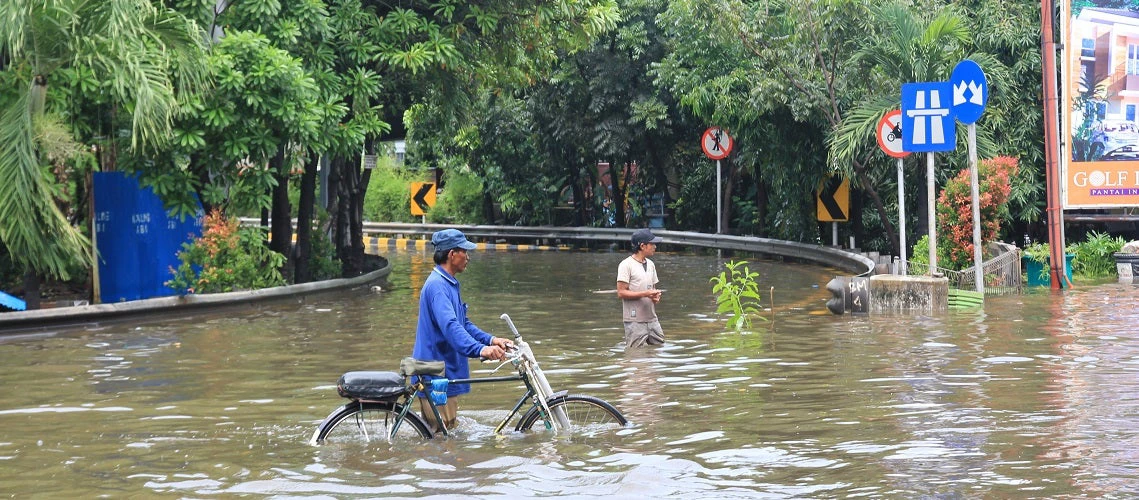 Man with a bicycle crossing a flooded road, waist deep in water, in Indonesia.
Man with a bicycle crossing a flooded road, waist deep in water, in Indonesia.
Climate change-induced disasters are increasing in frequency and intensity and pose a growing threat to development, with communities and infrastructure increasingly vulnerable. As countries develop long-term decarbonization and national adaptation plans, it has become crucial to screen for climate and disaster risk. Risk screening is a key step in the process of adapting to climate change and building resilience to shocks; it is also part of the World Bank Group’s commitment to align its financing with the Paris Agreement.
Over the past several years, the World Bank has developed a suite of climate and disaster risk screening tools. These tools help development professionals from a variety of sectors screen for risk during project preparation and sectoral- and national-level planning. The screening assessment serves as an initial effort to identify critical inherent risk exposure. It also determines the likelihood that climate and geophysical hazards will affect a project’s ability to achieve its development objective(s) and considers opportunities for climate-smart project design.
"Risk screening is a key step in the process of adapting to climate change and building resilience to shocks; it is also part of the World Bank Group’s commitment to align its financing with the Paris Agreement."
Climate and disaster risk screening was formally integrated into World Bank operations in 2014. Since then, it has been used in over 3,200 projects and helped 7,000 users conduct risk assessments. Its principal framework was adopted from the risk analyses and vulnerability assessments of the Intergovernmental Panel on Climate Change (IPCC) and the United States Agency for International Development’s (USAID). The methodology assists with identifying the critical hazards of a project’s location(s) and supports the management of appropriate adaptation and resilience measures.
Climate and disaster risk assessment has benefitted numerous projects. It has provided links to the best available climate data. Its methodology pinpoints notable climate hazards to a project’s assets, systems, and beneficiaries. It has also revealed climate risk in projects such as Harmonizing and Improving Statistics in West and Central Africa, which as a regional statistics project would not typically be considered exposed to such risk. However, through risk screening assessment, the project team considered potential exposure to hazards such as extreme temperature, drought, extreme precipitation, and rising sea levels. These hazards were then incorporated into adaptive measures in the project design – including agricultural statistics to inform farmers’ adaptivity to climate change and surveys to deepen the understanding of the vulnerability of households to climate shocks, as well as coping mechanisms.
"Climate and disaster risk screening was formally integrated into World Bank operations in 2014. Since then, it has been used in over 3,200 projects and helped 7,000 users conduct risk assessments."
In another example, the risk screening assessment of the Philippines Multisectoral Nutrition Project noted that climate events (such as typhoons, earthquakes, floods and storm surges) exacerbate food and nutrition insecurity. These events impact household food consumption by affecting which foods are available and at what price. They also affect child feeding and caring practices in a scenario where women may have multiple demands on their time, and they potentially impact water quality, supply and increase the transmission of water- and vector-borne diseases. In addition to these impacts, access to health facilities and health care service delivery may also be affected by climate events. These vulnerabilities and potential impacts were factored into the adaptation and resilience design components of the project.
"Climate and disaster risk screening is an essential first step to ensuring current and future climate hazards and geophysical risks are assessed and managed."
Climate and disaster risk screening tools website
A recently redesigned website contains the climate and disaster risk screening tools. These tools are available to World Bank staff, clients, and other users. They provide a structured and systematic way to flag potential risks at the national or policy level as well as at the project level. In all instances, the tools follow a convenient step-by-step approach so that users can understand the potential risks to programs and investments. In addition to the screening tools, the improved website offers sector resources, context-specific risk reduction activities, and a variety of case study examples.
Climate and disaster risk screening is an essential first step to ensuring current and future climate hazards and geophysical risks are assessed and managed. This step is critical in the World Bank’s alignment with the Paris Agreement and its objectives of mainstreaming climate and disaster resilience into key development policies, programs, and projects. We hope this practical tool continues to be beneficial as the Bank designs appropriate and pioneering climate-smart projects and policies.




Join the Conversation